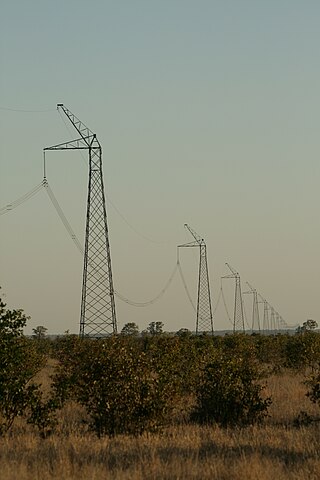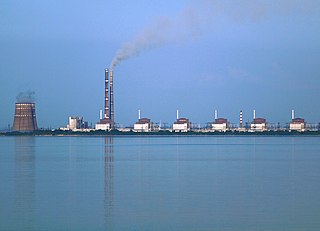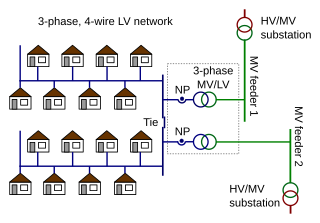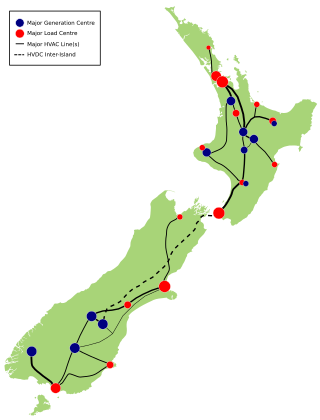
Electric power distribution is the final stage in the delivery of electricity. Electricity is carried from the transmission system to individual consumers. Distribution substations connect to the transmission system and lower the transmission voltage to medium voltage ranging between 2 kV and 33 kV with the use of transformers. Primary distribution lines carry this medium voltage power to distribution transformers located near the customer's premises. Distribution transformers again lower the voltage to the utilization voltage used by lighting, industrial equipment and household appliances. Often several customers are supplied from one transformer through secondary distribution lines. Commercial and residential customers are connected to the secondary distribution lines through service drops. Customers demanding a much larger amount of power may be connected directly to the primary distribution level or the subtransmission level.
The 2003 London blackout was a serious power outage that affected parts of south London and north-west Kent in the evening of 28 August 2003. It was caused by a series of faults at National Grid transmission substations, which supplied the distribution network operator in the area, EDF Energy.

A substation is a part of an electrical generation, transmission, and distribution system. Substations transform voltage from high to low, or the reverse, or perform any of several other important functions. Between the generating station and consumer, electric power may flow through several substations at different voltage levels. A substation may include transformers to change voltage levels between high transmission voltages and lower distribution voltages, or at the interconnection of two different transmission voltages. They are a common component of the infrastructure. There are 55,000 substations in the United States.

Single-wire earth return (SWER) or single-wire ground return is a single-wire transmission line which supplies single-phase electric power from an electrical grid to remote areas at lowest cost. Its distinguishing feature is that the earth is used as the return path for the current, to avoid the need for a second wire to act as a return path.

The National Grid is the high-voltage electric power transmission network serving Great Britain, connecting power stations and major substations, and ensuring that electricity generated anywhere on the grid can be used to satisfy demand elsewhere. The network serves the majority of Great Britain and some of the surrounding islands. It does not cover Northern Ireland, which is part of the Irish single electricity market.

The Chernobyl Nuclear Power Plant is a nuclear power plant undergoing decommissioning. ChNPP is located near the abandoned city of Pripyat in northern Ukraine, 16.5 kilometers (10 mi) northwest of the city of Chernobyl, 16 kilometers (10 mi) from the Belarus–Ukraine border, and about 100 kilometers (62 mi) north of Kyiv. The plant was cooled by an engineered pond, fed by the Pripyat River about 5 kilometers (3 mi) northwest from its juncture with the Dnieper.

The Zaporizhzhia Nuclear Power Station in southeastern Ukraine is the largest nuclear power plant in Europe and among the 10 largest in the world. It has been under Russian occupation since 2022. It was built by the Soviet Union near the city of Enerhodar, on the southern shore of the Kakhovka Reservoir on the Dnieper river. It is operated by Energoatom, who operate Ukraine's other three nuclear power stations.
The 2006 Auckland Blackout was a major electrical blackout in Auckland, the largest city in New Zealand, on 12 June 2006. It started at 08:30 local time, with most areas of Auckland regaining power by 14:45 local time. It affected some 230,000 customers and at least 700,000 people in and around the city.

In electricity distribution networks, spot network substations are used in interconnected distribution networks. They have the secondary network with all supply transformers bussed together on the secondary side at one location. Spot networks are considered the most reliable and most flexible arrangement of connecting power to all types of loads. Switching can be done without interrupting the power to the loads.

Hydro-Québec's electricity transmission system is an international electric power transmission system centred in Quebec, Canada. The system pioneered the use of very high voltage 735-kilovolt (kV) alternating current (AC) power lines that link the population centres of Montreal and Quebec City to distant hydroelectric power stations like the Daniel-Johnson Dam and the James Bay Project in northwestern Quebec and the Churchill Falls Generating Station in Labrador.

Amtrak's 25 Hz traction power system is a traction power network for the southern portion of the Northeast Corridor (NEC), the Keystone Corridor, and several branch lines between New York City and Washington D.C. The system was constructed by the Pennsylvania Railroad between 1915 and 1938 before the North American power transmission grid was fully established. This is the reason the system uses 25 Hz, as opposed to 60 Hz, which is the standard for power transmission in North America. In 1976, Amtrak inherited the system from Penn Central, the successor to the Pennsylvania Railroad, along with the rest of the NEC infrastructure.

An electrical grid is an interconnected network for electricity delivery from producers to consumers. Electrical grids consist of power stations, electrical substations to step voltage up or down, electric power transmission to carry power long distances, and lastly electric power distribution to individual customers, where voltage is stepped down again to the required service voltage(s). Electrical grids vary in size and can cover whole countries or continents. From small to large there are microgrids, wide area synchronous grids, and super grids.

The National Grid is the nationwide system of electric power transmission in New Zealand. The grid is owned, operated and maintained by Transpower New Zealand, a state-owned enterprise, although some lines are owned by local distribution companies and leased to Transpower. In total, the national grid contains 11,803 kilometres (7,334 mi) of high-voltage lines and 178 substations.

On 17 August 2009, a turbine in the hydroelectric power station of the Sayano-Shushenskaya Dam near Sayanogorsk in Russia failed catastrophically, killing 75 people and severely damaging the plant. The turbine hall was flooded, and a section of its roof collapsed. All but one of the ten turbines in the hall were destroyed or damaged. The entire power output of the plant, totalling 6,400 megawatts, was lost, leading to widespread power outages in the area. An official report on the accident was released in October 2009.

The 2010 Chile blackout was an electric power outage that affected most of Chile on March 14, 2010. It began at 8:44 pm on Sunday and continued into the next day. The power was restored in a few hours in some areas, and by midnight in most areas, except in the Biobío Region.

The Southeastern Pennsylvania Transportation Authority (SEPTA) operates a 25 Hz traction power system in the vicinity of Philadelphia, that it inherited from the Reading Company. This system is separate from, but similar to, the system built by the Pennsylvania Railroad (PRR), which is now operated by Amtrak. SEPTA's trains can run over either system because the voltage and frequency presented to the locomotive are essentially identical. However, the ex-Reading system is not electrically connected to the ex-PRR system.
Several major power outages have occurred in the country of Malaysia.

The West Side of Manhattan in New York City experienced a power failure on July 13, 2019, at approximately 7 p.m. EDT. Con Edison is the energy utility serving the area, and they reported that approximately 73,000 customers were without power. Power was fully restored by midnight. The power failure occurred on the 42nd anniversary of the New York City blackout of 1977, which left nine million customers without power.
Electrical grid security in the United States involves the physical and cybersecurity of the United States electrical grid.















